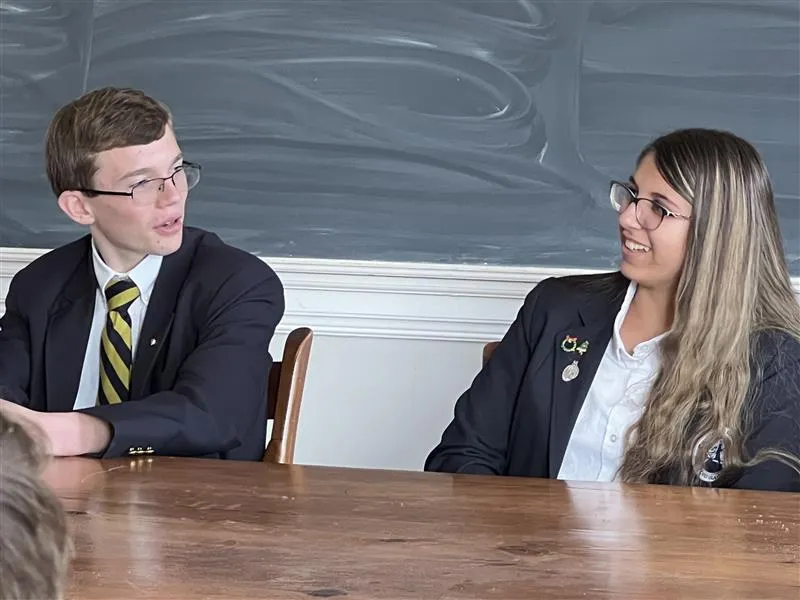
Washington, D.C. Newsroom, Feb 2, 2024 / 09:22 am (CNA).
Half of all children raised Catholic will go on to abandon the faith, according to a study by the Pew Research Center. Another Pew study found that as more and more young adults continue to lose their faith, religious “nones” have become the country’s largest religious group.
To Dale Ahlquist, a Catholic author, speaker, and president of the Gilbert Keith Chesterton Society, the root of the problem lies in a “crisis” in education. Yet, Ahlquist believes that a growing network of Catholic schools based on the thought and writings of G.K. Chesterton just might have the solution.
Rooted in the “truth, goodness, and beauty” of thousands of years of Catholic tradition and buttressed by an ever-expanding network of high schools across the country — 59 and counting — more and more Catholic parents are opting to send their teens to a “Chesterton Academy.”

What is a Chesterton Academy?
Ahlquist, who helped found the first Chesterton Academy in 2008, told CNA that the Chesterton academies combine faith and reason, and rather than teaching students what to think, they teach them how to think.
Ahlquist lamented that many Catholic schools today follow the example of public schools, bucking deeply Catholic traditional ideas of education in favor of new, often experimental, modernist education ideas.
Meanwhile, at the heart of every Chesterton academy, Ahlquist said, lies the Eucharist, the sacraments, and adherence to tried and proven classical education methods.
Chesterton, a renowned 20th-century Catholic author best known for such works as the “Father Brown” series and “Orthodoxy,” is often referred to as “the apostle of common sense.” A man deeply in tune with both his faith and the world, many of Chesterton’s writings can seem prophetic to the state of the world today.
As early as 1910, Chesterton decried the Western education system for often adopting curricula younger than the students themselves.
“It ought to be the oldest things that are taught to the youngest people; the assured and experienced truths that are put first to the baby. But in school today the baby has to submit to a system that is younger than himself,” he wrote in his book “What’s Wrong with the World.”
“Many a school,” he went on, “boasts of having the latest ideas in education when it has not even the first idea; for the first idea is that innocence, divine as it is, may learn something from experience.”
Now with such ideologies as critical race theory and gender fluidity rampant throughout the American education system, the Chesterton academies are resounding with more and more parents and students.

Even still, one major roadblock parents often face when looking for a Catholic and classical education is high tuition costs. Yet Ahlquist explained that another core aspect of the Chesterton Academy is making education affordable for families.
“We knew we wanted it to be affordable,” he said. “We would have gone to another school if we could have found all three of those things in another school, but we couldn’t. And that’s why we started our own school, so it was going to be Catholic, classical, and affordable.”
Just 16 years later there are 59 schools in 25 states and four countries, with 10 more academies expected to open in the fall.
The secret to the academies’ success, Ahlquist believes, is that they fill an urgent need and hunger of parents and students for a school that truly teaches and lives out the joy of the faith.
What do students learn at the Chesterton academies?
Every class is taught in the Socratic method of question and answer. Even more unique, Ahlquist said that each course ties in with the other so that what a student is learning in history then connects to what he or she is learning in philosophy, math, or science.
“We don’t only teach religion in a theology class, we teach it in literature and history and in art and even in the science classes,” Ahlquist said. “G.K. Chesterton says, ‘Thinking means connecting things,’ and we make a great work of doing that so that the four-year curriculum is very intricately woven, so everything is tied together.”
The goal is to train students to be well-rounded and knowledgeable Catholics. Every student at a Chesterton academy undergoes four years of math, science, literature, philosophy, languages, history, art, music, drama, and even choir and ballroom dance.

“I’ve called G.K. Chesterton the complete thinker,” Ahlquist said. “He’s the kind of thinker we’d like our students to become in that he wrote and thought about everything.”
Lest one thinks that the Chesterton academies are merely liberal arts schools with no bearing on the real world, Ahlquist said that math and science play a central role in the students’ educations.
“Math is all about solving problems,” he said, noting that in many public schools “students are not learning even the basic skills of math and reading.”
“These students come out of Chesterton Academy knowing how to solve problems, and most of life is solving problems. But we try to put the faith at the center of their lives, and they come out with a deep and productive faith.”
What’s it like to attend a Chesterton academy?
Azin and Bill Leary, parents and co-founders of the Chesterton Academy in Annapolis, Maryland, told CNA that the school has transformed their family’s life for the better.
“It’s just so beautiful to see that what’s being taught at school is not contradictory to what we’re trying to do at home,” Azin Leary said.
Mass, adoration, and confession all play a crucial part in the life of the school and are made readily available. For the students and faculty, each day begins with the celebration of Mass at 8 a.m. After that, classes begin, but not before prayer and the pledge of allegiance.

Besides academics, students at the Annapolis academy can also participate in sports including soccer, baseball, tennis, and volleyball, as well as several student-led clubs.
The Learys said they love how much each subject is integrated into the other, something they said helps students connect the dots between faith and reason. The Socratic style in the classes, they said, encourages students to ask questions and even voice disagreement with teachings that don’t make sense to them.
When new students come to the academy, Azin said that one of the things they often say is: “Oh, I’m allowed to ask questions, I’m actually allowed to discuss things with my teacher and disagree with my teachers?” To which they respond: “Absolutely, this is where you learn how to think, not what to think.”
Far from giving in to the moral and religious relativism so prevalent in the modern education system, the Learys said that giving students the freedom to question teachings strengthens their faith and equips them to defend it.
“We can’t keep our kids in a bubble,” Azin said. “They have to go and fight and they have to be the future leaders … what a beautiful way for them to start as teenagers to learn about freedom.”
“We’re teaching the kids logic and rhetoric and how to communicate, how to understand fallacies,” Bill chimed in. “So, if over time, the Chesterton school students, including ours at Annapolis, learn how to spot those fallacies, how to have conversations, how to listen to the other side, we’re hoping that these students will go out there and, with a strong Catholic tradition, be able to make a difference out there in the world.”

Evangelization through education
Ahlquist said he would advise any parent considering a Chesterton Academy education for their children that “there’s absolutely nothing more important than the souls of their children.”
“The high school experience is really one of the most pivotal times in their lives. If they’re not well formed at that stage, they’re not going to do well in college or wherever they go on to because they won’t have a grounding in faith and reason,” he said.
At Chesterton, Ahlquist said: “We can really prepare their minds at a very critical time of their lives.”
According to Ahlquist, the Chesterton schools’ mission comes down to “evangelization through education.”
“We really are proclaiming the Gospel by simply teaching the truth to our students because the Gospel is going to be spread just by forming their hearts and minds at this important time in their lives,” he explained. “We’ve seen lives changed and we have conversions at our schools, but the people who intersect or who just cross our paths, their lives are affected in a positive way [too]. They see a lot of Catholic joy.”
Ultimately, Ahlquist concluded: “That’s how you change a culture and change a society.”
If you value the news and views Catholic World Report provides, please consider donating to support our efforts. Your contribution will help us continue to make CWR available to all readers worldwide for free, without a subscription. Thank you for your generosity!
Click here for more information on donating to CWR. Click here to sign up for our newsletter.






Who cannot be touched by the smiling faces of God’s beautiful children? Their joy is a testament to their faith, which can change the world for the better.